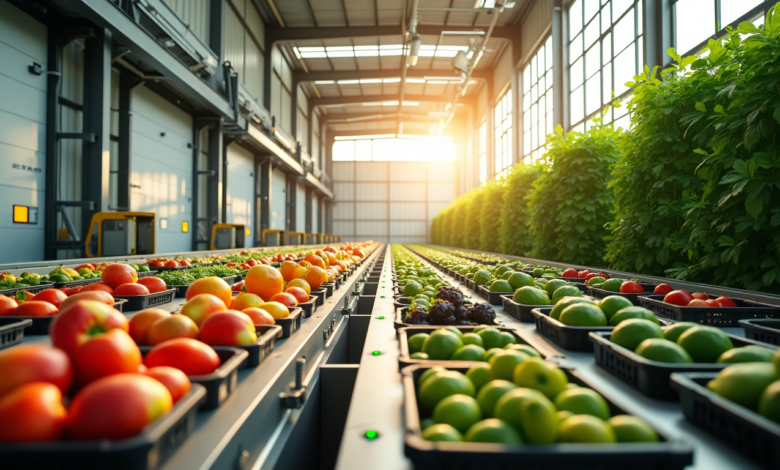
How to Revolutionize the Food Space with Sustainable Practices
The food industry stands at a critical turning point. Traditional supply chains create environmental challenges daily through excessive carbon emissions and food waste. These issues need quick and effective solutions.
Making food chains greener isn’t just good for the environment—it’s crucial for business success. Consumers, regulators, and stakeholders push companies to embrace environmentally responsible methods across their operations.
Let’s look at practical ways to change food supply chains. You’ll learn about technology-driven solutions, environmentally sound production techniques, and ways to measure environmental effects that will help create a greener future.
Technology-Driven Supply Chain Solutions
The food industry faces a technological revolution that changes supply chain management. Artificial intelligence (AI) leads this transformation by revolutionizing inventory management with increased efficiency, forecasting, and decision-making capabilities.
AI-powered solutions deliver remarkable improvements in operational efficiency. These systems cut delivery costs by up to 20%. Trucks now handle 110 routes per week instead of 75, which shows significant progress in route optimization.
Blockchain technology adds another dimension to this transformation. The technology enables tracking food origin in seconds instead of days while providing complete visibility. Market projections show the global blockchain market for food supply chain will reach $2.71 billion by 2028, with a CAGR of 46.7%.
These technological solutions offer key benefits:
- Greater accuracy in inventory forecasting
- Live visibility across supply chains
- Automated compliance reporting
- Better food safety monitoring
IoT-enabled smart containers have proven highly effective in our industry. Cloud storage receives precise sensory data from these containers to enable better supply chain management. The combination with blockchain technology allows monitoring of location, temperature, and humidity conditions for food products during transit and storage.
AI-powered analytics and sensor technology now analyze water and soil’s chemical composition instantly. This capability leads to better irrigation and harvesting strategies. The technology integration goes beyond efficiency improvements – it creates a more transparent and environmentally responsible food supply chain for tomorrow.
Sustainable Production Practices
Eco-friendly practices in food production are vital to ensure future viability and protect our environment. The way we design and operate production systems has changed radically, and sustainability now sits at their heart.
Our sustainable food production has these practices that are revolutionizing the industry:
- Implementation of resource-efficient agricultural practices
- Development of sustainable food value chains
- Integration of climate-smart technologies
- Improvement of soil fertility management
- Optimization of water conservation methods
Sustainable agricultural practices show impressive results on many fronts. Agriculture takes up about 50% of Earth’s habitable land. This makes it vital to protect and improve these valuable resources.
Water management shows great improvements through new conservation methods. The food processing industry uses about one-third of total freshwater. Global water usage will likely rise by 53% by 2030. These numbers make water conservation a top priority in our sustainability efforts.
Energy efficiency gains in food processing have brought exciting results. Smart implementations help facilities save 10-15% energy with new technologies. Refrigeration systems can save up to 30% of base electrical usage.
Our steadfast dedication to sustainable production goes beyond environmental impact. Rural livelihoods need support and decent income through long-term viable farming systems. Local processing and direct market access create innovative ways out of poverty through sustainable food value chains.
Measuring Environmental Impact
Environmental impact measurement in the food industry has become more important as regulations change and stakeholders want more transparency. The industry is moving toward complete environmental monitoring and reporting.
New regulatory requirements now affect about 5,300 companies under California’s recent legislation. These companies must publicly disclose their greenhouse gas emissions. The disclosures need to include Scope 1, 2, and 3 emissions. Supply chain emissions typically make up more than 90% of a corporation’s carbon footprint.
Several vital metrics help measure environmental impact:
- Greenhouse gas emissions and carbon footprint
- Water usage and quality indicators
- Waste management metrics
- Energy consumption patterns
- Supply chain sustainability indicators
Environmental traceability has become a vital tool in measurement efforts. Digital technologies help track environmental effects throughout the supply chain. Companies can meet their ambitious environmental goals while simplifying data handling.
Standardized reporting frameworks guide our measurement approach. The Global Reporting Initiative (GRI), Carbon Disclosure Project (CDP), and Task Force on Climate-Related Financial Disclosures (TCFD) offer reliable metrics to measure sustainability performance. These frameworks establish consistent methods to measure and report practices across the industry.
Food systems contribute heavily to global environmental pressures, including greenhouse gas emissions, water pollution, and biodiversity loss. Strong measurement systems help identify areas for improvement and track progress toward sustainability goals effectively.
The food supply chain needs to go green. This shift isn’t just good for the environment—it’s crucial for businesses to survive and grow. Companies can create real change and stay efficient by using technology, sustainable practices, and measuring their environmental effect.
AI and blockchain technologies deliver impressive results. These smart solutions cut delivery costs by 20% and track food instantly. New production methods also help companies use 30% less water and energy. These advances create practical ways to protect our environment.
Companies need solid ways to measure their progress. Environmental monitoring systems help track changes effectively. Stricter regulations and higher stakeholder demands make these changes necessary. Businesses that accept new ideas now will thrive later.
Green supply chains need careful planning and dedication. Lower costs, better efficiency, and environmental protection make the effort worth it. Companies taking action today will lead tomorrow’s sustainable food industry.




